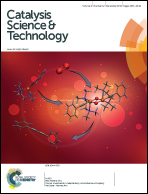Carbonates as reactants for the production of fine chemicals: the synthesis of 2-phenoxyethanol†
Abstract
The solventless and heterogeneously catalysed synthesis of 2-phenoxyethanol (ethylene glycol monophenyl ether) via the reaction between phenol and ethylene carbonate was investigated using Na-mordenite catalysts as an alternative to the industrial process using ethylene oxide and homogeneous basic conditions. Under specific reaction conditions, it was possible to obtain total selectivity to phenoxyethanol at up to 75% phenol conversion and 82% selectivity at total phenol conversion in 5–7 hours of reaction time and using a moderate excess of ethylene carbonate. The main by-product was the linear carbonate of phenoxyethanol, bis(2-phenoxyethyl)carbonate (selectivity 15%), which could then be converted to phenoxyethanol by reacting with phenol in basic medium with 100% yield; so overall, the phenoxyethanol yield was as high as 97%. With a stoichiometric feed of phenol and ethylene carbonate, the maximum conversion of phenol was just 60%, still with 100% selectivity to phenoxyethanol. An autocatalytic phenomenon was also observed due to the higher basicity of 2-phenoxyethanol compared to phenol, which overlapped the Na-catalyzed activation of phenol. Starting from a commercial Na-mordenite, which showed significant deactivation, and by applying a post-treatment aimed at the reduction of microporosity, it was possible to minimize both the deactivation and Na leaching while keeping the selectivity enhancement effect shown by the mordenite structure.



 Please wait while we load your content...
Please wait while we load your content...